« Prev Next »

Agricultural crops are regularly infested with insect pests whose population size can reach outbreak densities in some years, causing considerable income loss to farmers. In general, the risk of pest outbreaks is highest when insects disperse to crop fields early in the growing season and the population growth rate is high. The population growth rate measures how much the population size (i.e., number of individuals of a species in a defined area) changes per unit time. Suites of natural enemies (predators and parasitoids) prey upon insects and thereby reduce the risk of pest insects causing economically significant damage. The most common tool for farmers to control pest insects is the application of insecticides. However, unnecessary insecticide applications incur costs to purchase and use and may increase future pest problems by killing beneficial insects. Scientists can help farmers avoid unnecessary insecticide applications using mathematical models to predict future pest population sizes. Predicting future population sizes and evaluating what factors are most critical for population growth are also essential to other areas in ecology such as invasive species management and conservation ecology.
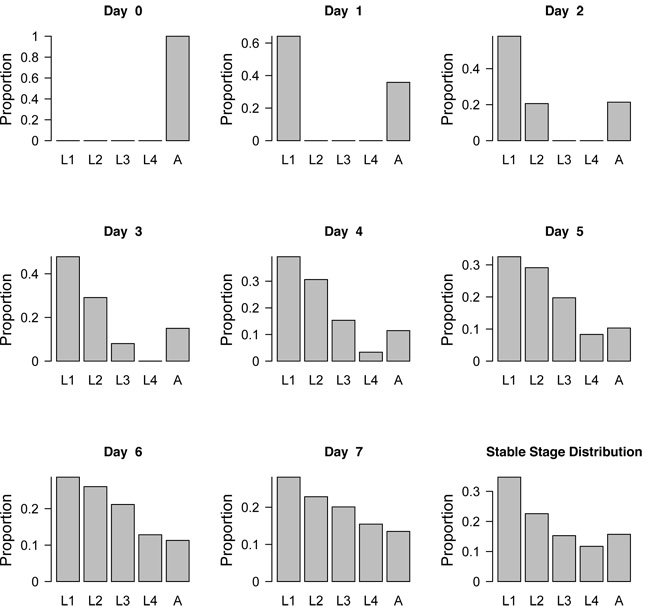
Populations consist of individuals that differ in age, size, or developmental stage (e.g., the relative proportion of eggs, juveniles, and adults). The distribution of individuals among these categories is known as the stage distribution of the population. The stage distribution influences the population growth rate and varies through time. Interestingly, if environmental conditions remain constant long enough, the stage distribution settles into a particular pattern in which the relative proportion of the different stages remains constant over time. This is called the "stable stage distribution." Imagine some adult aphids disperse to an alfalfa field in the spring (Figure 1). Initially the population consists of only adult aphids (Day 0). As soon as the adults give birth, the population consists of adults and newborn aphids (Day 1). Aphid larvae have four juvenile stages, called instars, through which they develop to become adults; newborn aphids are in the first instar. By Day 2, some first instar aphids have grown enough to molt and become second instar larvae; at the same time, more first instar larvae are born. By Day 4, the aphid population consists of all four juvenile stages and the adult stage, but the relative proportion of stages still changes for some time. If nothing else changes, the population eventually reaches the stable stage distribution and the speed at which the population is growing approaches a constant rate (the asymptotic population growth rate). This means that although the proportion of individuals in each stage is constant, the total population is still growing at a constant rate. However, while the stage distribution is changing, the population growth rate may be completely different (Figure 2).
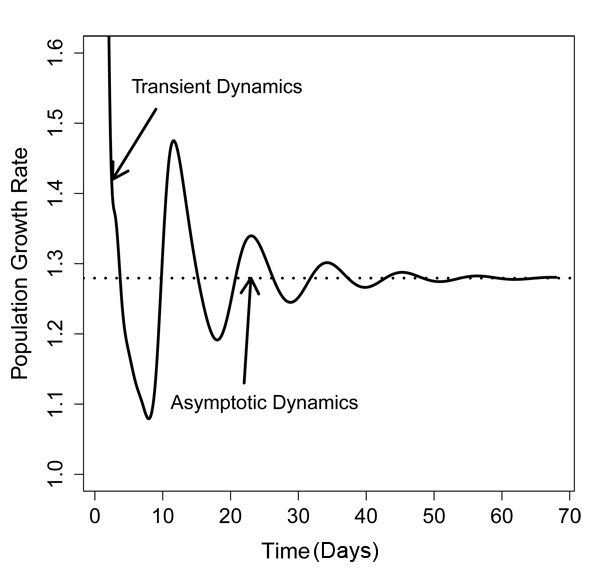
When Are Short-Term (Transient) Dynamics Important?
The fluctuations in population growth rate following the dispersal event are known as transient dynamics because the fluctuations do not persist. In the past, ecologists focused on studying the long-term dynamics, or asymptotic dynamics, assuming that populations have been around for long enough to approach a stable stage distribution. However, there is an increasing awareness that many populations experience disturbances, like fire or drought, which push the population away from the stable stage distribution. For instance, after a wildfire, all adults of a fire intolerant species die, and all that is left are the seeds in the seed bank. Although the plant population will resume growing after a fire, it may take several years before the population reaches the stable stage distribution again. If the interval between fires is shorter than the time required to reach the stable stage distribution, the population dynamics may be better described by transient dynamics.
Transient population dynamics may also play an important role for species exploiting ephemeral resources, such as pioneer plants that frequently colonize new areas. The population growth rate during the early phase of a colonization event influences the likelihood of successful establishment. The founder population is initially highly skewed toward the dispersal stage (like seeds or seedlings for plants or adults for many animal species) and typically consists of only a few individuals. Small populations have a high inherent risk of extinction because of Allee effects and demographic stochasticity; therefore, the transient population growth rate determines how quickly a founder population remains in the stage of dangerously small numbers.
In general, transient dynamics are expected after any disturbance (biotic or abiotic) that causes a deviation from the stable stage distribution. Examples include flood or drought which may have different impacts on each life history stage. For example, newborns may be more likely to die in a drought than adults or large grazers moving temporarily through an area that have a preference for young, juicy plants. In contrast, we do not expect transient dynamics if the biotic or abiotic factors are consistently present, such as specialist predators that reliably consume seeds every year; their impact on plant demography is already incorporated into the stable stage distribution.
Mathematical Models
Transient dynamics may be important for many aphid species because they exploit ephemeral resources. Aphid populations typically crash three to four generations after dispersing to their host plants (Dixon & Agarwala 1999) because host plant quality decreases with time and the pressure of natural enemies increases. My colleagues and I (Tenhumberg et al. 2009) used a matrix population model of pea aphids to compare predicted trajectories of populations that started out with 100% adults (adults are the dispersal stage of aphids) or with populations that started out at the stable stage distribution. Transient dynamics are expected in the former and asymptotic dynamics in the latter scenario.
Pea Aphids Experiments
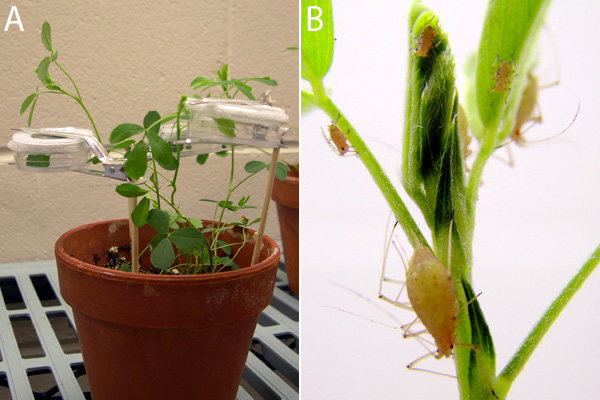
Pea Aphid Model
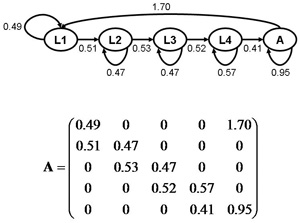
Estimating the future size of a population that starts out from any other stage distribution involves simulations. For this, we divided the population N0 into the different stages: in our "dispersal scenario," we assumed all individuals of N0 belong to the "young adult" stage, and the number of individuals in all other stages was zero. In our equilibrium scenario, all individuals were distributed among the different stages according to the stable stage distribution. For instance, if for a population of N0 equals 100 individuals in the stable stage distribution 35% of the population is in the first instar, then the first instar stage would get 35 individuals. The number of individuals in the different stages were entered into a starting population vector n(t = 0). Then we simulated the population trajectories of both scenarios using this formula: n(t + 1) = An(t). From one day to the next (from t to t+1) the number of individuals in the different stages changed; and so did the total population size (the sum of the number of individuals in the different stages). Figure 4 provides a generic example of a population projection matrix.
Simulation Results
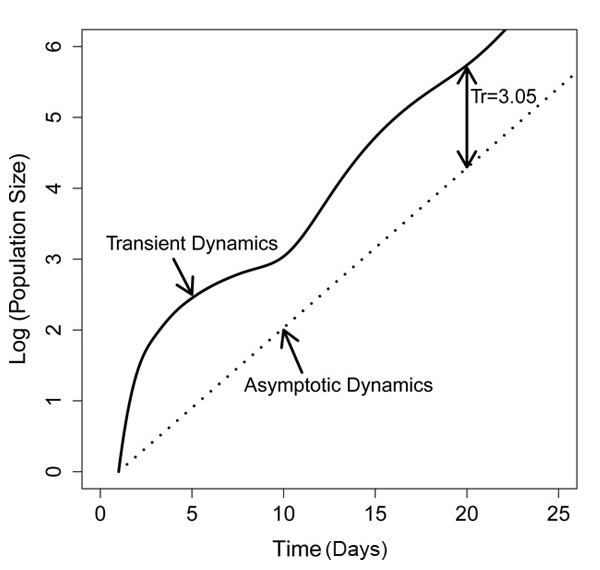
Other Pitfalls
Conclusions
References and Recommended Reading
Caswell, H. Matrix Population Models, 2nd ed. Sunderland, MA: Sinauer & Associates, 2001.
Dixon, A. F. G. & Agarwala, B. K. Ladybird-induced life-history changes in aphids. Proceedings of The Royal Society B 266,1549–1553 (1999).
Tenhumberg, B. et al. Model complexity affects predicted transient population dynamics following a dispersal event: a case study with Acyrthosiphon pisum. Ecology 90,1878–1890 (2009).






























